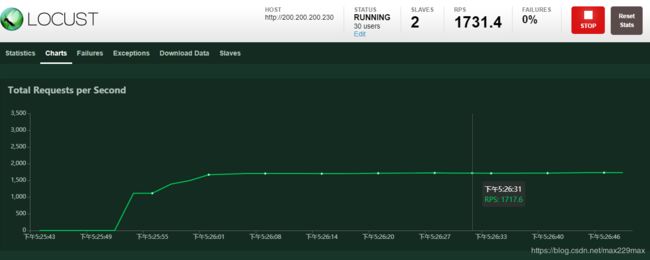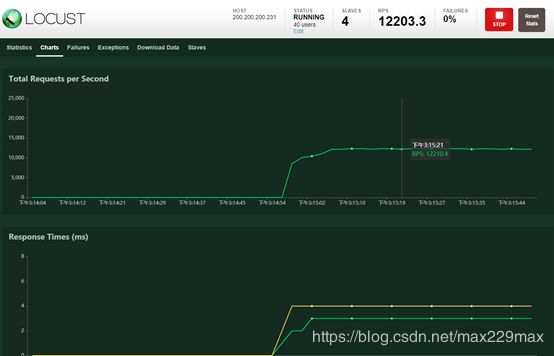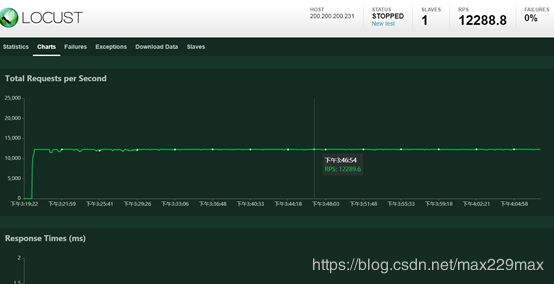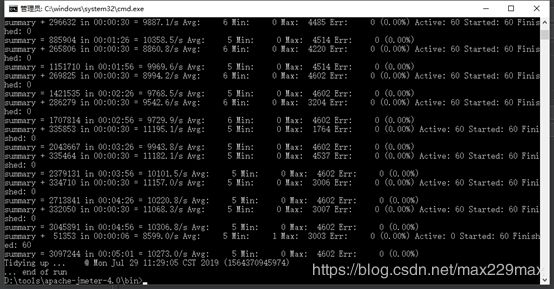python - Locust各种http client 测试
python - Locust各种http client 测试
Max.Bai
2019-08
Table of Contents
python - Locust各种http client 测试
0x00 前言
0x01 locust自带client
0x02 http.client
0x03 geventhttpclient
0x04 Urllib3
0x05 go net.http
0x06 go fasthttp
0x07 Jmeter
0x08 结果
0x00 前言
Locust是一个python的分布式性能测试工具,可以通过python编程实现各种协议的压测,详细查看locust官网 https://locust.io/
经过长时间的使用大家肯定会发现,高并发的时候locust还是不错的选择,但是需要高压力的时候,经常觉得locust压力不够(资源有限)
今天测试的目的是测试各种http client的性能在locust中的表现。
涉及的client都有:
python http.client
python geventhttpclient
python urllib3
go net.http
go fasthttp
java Jmeter
测试的服务端是4cpu 的Nginx服务。
客户端是4 cpu centos6.5
下面的测试没有记录服务器的消耗,主要是服务器没有到瓶颈,客户端已经到了瓶颈,网路卡住了。
0x01 locust自带client
locust自带client是requests, 功能强大,但是性能就一般了。
代码:
#!/usr/bin/env python
#coding:utf-8
from locust import HttpLocust, TaskSet, events, task
class WebsiteUser(HttpLocust):
host = "http://200.200.200.230"
min_wait = 0
max_wait = 0
class task_set(TaskSet):
@task
def index(self):
self.client.get('/')
if __name__ == '__main__':
user = WebsiteUser()
user.run()10 user 1 slave 使用中客户端cpu使用100%
30 user 2 slave 使用中客户端cpu使用100%
0x02 http.client
python3 中的http.client, 使用晦涩,但是性能比requests 确实高了不少。
代码:
#!/usr/bin/env python
#coding:utf-8
import time
# import StringUtils
import random
import json
import requests
from threading import Lock
from requests.exceptions import HTTPError, Timeout, ConnectionError, TooManyRedirects, RequestException
from locust import HttpLocust, TaskSet, events, task
import http.client
class WebsiteUser(HttpLocust):
host = "200.200.200.231"
min_wait = 0
max_wait = 0
class task_set(TaskSet):
def on_start(self):
self.conn = http.client.HTTPConnection("200.200.200.230")
def teardown(self):
self.conn.close()
print('close')
@task
def index(self):
method = "GET"
payload = ''
try:
start = int(time.time()*1000)
self.conn.request(method, '/')
response = self.conn.getresponse()
data = response.read()
# print(data)
c1 = int(time.time()*1000)
res_time = c1-start
if response.status == 200:
events.request_success.fire(request_type="POST", name="scene", response_time=res_time, response_length=0)
else:
events.request_failure.fire(request_type="POST", name="scene", response_time=res_time, exception="report failed:{}".format(res.text))
except Exception as e:
events.request_failure.fire(request_type="POST", name="scene", response_time=10*1000, exception="report failed:{}".format(str(e)))
self.interrupt()
# print('c:{}'.format(int(time.time()*1000)-c1))
if __name__ == '__main__':
user = WebsiteUser()
user.run()10 user 1 slave 使用中客户端cpu使用100%

40 user 4 slave 使用中客户端cpu使用100%
0x03 geventhttpclient
locust 另外提供了geventhttpclient, https://github.com/locustio/geventhttpclient
这个client性能确实不错,主要是由C实现的底层。
代码:
#!/usr/bin/env python
#coding:utf-8
import time
from locust import HttpLocust, TaskSet, events, task
from locust.exception import LocustError, StopLocust
from geventhttpclient import HTTPClient
from geventhttpclient.url import URL
class WebsiteUser(HttpLocust):
host = "200.200.200.231"
min_wait = 0
max_wait = 0
class task_set(TaskSet):
min_wait = 0
max_wait = 0
def on_start(self):
url = URL('http://200.200.200.230/')
self.conn = HTTPClient(url.host)
def teardown(self):
self.conn.close()
print('close')
@task
def index(self):
method = "GET"
payload = ''
try:
start = int(time.time()*1000)
response = self.conn.get('/')
data = response.read()
# print(data)
c1 = int(time.time()*1000)
res_time = c1-start
if response.status_code == 200:
events.request_success.fire(request_type="POST", name="scene", response_time=res_time, response_length=0)
else:
events.request_failure.fire(request_type="POST", name="scene", response_time=res_time, exception="report failed:{}".format(res.text))
except Exception as e:
events.request_failure.fire(request_type="POST", name="scene", response_time=10*1000, exception="report failed:{}".format(str(e)))
raise LocustError
def testarg(a:str=None):
print(a)
if __name__ == '__main__':
user = WebsiteUser()
user.run()
10 user 1 slave 使用中客户端cpu使用100%
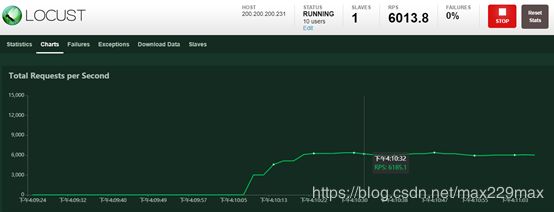
30 user 2 slave 使用中客户端cpu使用100%
0x04 Urllib3
python3 有个urllib3的包,里面也有http client
代码:
#!/usr/bin/env python
#coding:utf-8
import time
from locust import HttpLocust, TaskSet, events, task
import urllib3
class WebsiteUser(HttpLocust):
host = "200.200.200.231"
min_wait = 0
max_wait = 0
class task_set(TaskSet):
def on_start(self):
self.conn = urllib3.PoolManager()
@task
def index(self):
url = "http://200.200.200.230/"
method = "GET"
payload = ''
try:
start = int(time.time()*1000)
response = self.conn.request(method, url)
c1 = int(time.time()*1000)
res_time = c1-start
if response.status == 200:
events.request_success.fire(request_type="POST", name="scene", response_time=res_time, response_length=0)
else:
events.request_failure.fire(request_type="POST", name="scene", response_time=res_time, exception="report failed:{}".format(res.text))
except Exception as e:
events.request_failure.fire(request_type="POST", name="scene", response_time=10*1000, exception="report failed:{}".format(str(e)))
self.interrupt()
if __name__ == '__main__':
user = WebsiteUser()
user.run()30 user 2 slave 使用中客户端cpu使用100%
0x05 go net.http
有大神用go语言实现了 locust 的slave,http client 使用net.http, 脚本使用的是大神提供的sample
https://github.com/myzhan/boomer
10 user 1 slave 使用中客户端cpu使用75%
30 user 3 slave 使用中客户端cpu使用60%
0x06 go fasthttp
fasthttp 是比net.http还要快的client,所以大神也提供了demo
https://github.com/myzhan/boomer
10 user 1 slave 使用中客户端cpu使用45%
0x07 Jmeter
Jmeter是java的压测工具,我也使用Jmeter做了个简单的测试。
Jmeter使用 20 个线程
Jmeter使用 60个线程
0x08 结果
比较过程比较粗糙,但是基本可以看出来各个client的性能了。
go fasthttp > go net.http > python geventhttpclient > python http.client > python urllib3
当然,使用过程中看自己对语言的掌握程度,手上的资源,衡量选择go的还是python的库。

